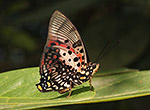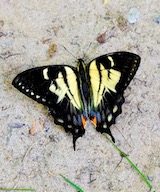-
kevinkk

- Premium Member - 2025

- Posts: 534
- Joined: Mon May 23, 2022 5:06 pm
Hyalophora hybrid larva
by kevinkk » Mon Jun 16, 2025 10:52 pm
Now I wish I had the respective animals to compare, these seem to look more bluish than pure euryalus,
it'll be interesting to see how they develop, it just occurred to me to take pictures today..
Preferred ceanothus over cherry though, the larva split 60% for ceanothus and the rest for cherry
-
wollastoni

- Site Admin

- Posts: 685
- Joined: Fri Mar 18, 2022 9:51 am
Re: Laos - April 2025
by wollastoni » Mon Jun 16, 2025 9:06 am
I will send you my friends' contact by PM. He will get my Laotian specimens in end-September only as we will meet in Juvisy fair.mokky wrote: Sun Jun 01, 2025 9:27 am Wow, I would like to know which species you collected there. I am interested in this lovely Lycaenidae. If you know anyone who shares same passion as me, please introduce those friednds to me!
-
bobw

- Global Moderators

- Posts: 269
- Joined: Tue Mar 22, 2022 2:53 pm
Re: Siderone
by bobw » Mon Jun 16, 2025 8:29 am
-
wollastoni

- Site Admin

- Posts: 685
- Joined: Fri Mar 18, 2022 9:51 am
Re: Siam Butterfly Farm -Thailand
by wollastoni » Mon Jun 16, 2025 8:09 am
-
wollastoni

- Site Admin

- Posts: 685
- Joined: Fri Mar 18, 2022 9:51 am
Re: Siderone
by wollastoni » Mon Jun 16, 2025 7:57 am
-
Oger

- Posts: 2
- Joined: Sun Jun 15, 2025 5:19 pm
Re: Small white insect
by Oger » Sun Jun 15, 2025 7:40 pm
-
daveuk

- Premium Member - 2025

- Posts: 905
- Joined: Mon May 23, 2022 8:08 pm
Re: Siderone
by daveuk » Sun Jun 15, 2025 6:53 pm
(Presumably S. marthasia form)
- Attachments
-
- Screenshot_20250615_194636_Gallery.jpg (325 KiB) Viewed 111 times
-
- Screenshot_20250615_194628_Gallery.jpg (455.22 KiB) Viewed 111 times
-
livingplanet3

- Premium Member - 2025

- Posts: 717
- Joined: Tue May 24, 2022 4:55 pm
Re: Small white insect
by livingplanet3 » Sun Jun 15, 2025 6:06 pm
These insects appear to have been killed by an entomopathogenic fungus, which are parasitic fungi that only infect insects. This may simply be a natural occurrence, although some of these fungi are used agriculturally as biological control agents against crop pests such as thrips, aphids, and whiteflies.Oger wrote: Sun Jun 15, 2025 5:28 pm Hello,
Today when i was outside i noticed these very small insects? They either fell from the sky or blew from somewhere, like small flakes. There are problably hundreds of them, all dead, where i live in middle of Sweden. Any idea of what they are? They are roughly 1-2mm in size.
-
Oger

- Posts: 2
- Joined: Sun Jun 15, 2025 5:19 pm
Small white insect
by Oger » Sun Jun 15, 2025 5:28 pm
Today when i was outside i noticed these very small insects? They either fell from the sky or blew from somewhere, like small flakes. There are problably hundreds of them, all dead, where i live in middle of Sweden. Any idea of what they are? They are roughly 1-2mm in size.
-
Shabadoo

- Posts: 1
- Joined: Sun Jun 15, 2025 3:54 pm
Small insect ID help
by Shabadoo » Sun Jun 15, 2025 4:20 pm
- Attachments
-
- IMG_4525-compressed.jpeg (637.3 KiB) Viewed 32 times
-
Chuck

- Posts: 1440
- Joined: Mon May 23, 2022 2:30 pm
Re: Tiger Swallowtails of NY: Finger Lakes, Part II
by Chuck » Sat Jun 14, 2025 3:49 pm
I doubt it. Mainly because it first landed at a rusty puddle and was sucking from that. And later landed on goose poop where it was captured. But mainly because it kept flying around the asphalt, would touch it, and fly off just to try again. This says to me it looked good but didn’t taste good.adamcotton wrote: Fri Jun 13, 2025 7:47 pm
It is possible that something (dog or other animal) pee'd on the asphalt, and the Tiger was responding to that.
Adam.
I’ve seen them do this with Purple Crownvetch in a field of milkweed. The flowers of both are the same color. So they’ll land on the crownvetch and quickly jump off, and keep trying until they happen to land on a milkweed.
-
mothman55

- Premium Member - 2025

- Posts: 138
- Joined: Mon May 23, 2022 12:09 pm
-
eurytides

- Posts: 302
- Joined: Tue May 24, 2022 1:36 am
Re: Beware - Matthew Nochisaki
by eurytides » Sat Jun 14, 2025 12:13 am
-
adamcotton

- Global Moderators

- Posts: 1112
- Joined: Tue Mar 22, 2022 12:24 pm
Re: Tiger Swallowtails of NY: Finger Lakes, Part II
by adamcotton » Fri Jun 13, 2025 7:47 pm
It is possible that something (dog or other animal) pee'd on the asphalt, and the Tiger was responding to that.Chuck wrote: Fri Jun 13, 2025 4:03 pm An oddly interesting observation:
A "spring form" male was flying around looking for a place to puddle, on an old steel barge. He kept returning to what looked like a pile of racoon poop, but isn't- it's a random pile of 100 year old asphalt that looks like poo.
I wonder- are they using vision to find puddling resources? I always assumed that it's scent. That said, a puddle group attracts others, and that's clearly visual.
Butterflies clearly do use visual cues for many things too and they are often attracted to particular coloured objects. Once, in E Laos, I saw multiple butterflies investigating a discarded can, which was shiny pale blue.
Adam.
-
Chuck

- Posts: 1440
- Joined: Mon May 23, 2022 2:30 pm
Re: Tiger Swallowtails of NY: Finger Lakes, Part II
by Chuck » Fri Jun 13, 2025 4:09 pm
I went to Huntsville AL for a few days. Found Tigers nectaring on Turtlehead and Thistle but only up in the hills, none in the valleys. Couple interesting notes to record, (1) they are smaller than the Tigers in KY, and (2) many have the ventral side HW black line that separates black/yellow as straight-ish, like P solstitius and canadensis.
-
Chuck

- Posts: 1440
- Joined: Mon May 23, 2022 2:30 pm
Re: Tiger Swallowtails of NY: Finger Lakes, Part II
by Chuck » Fri Jun 13, 2025 4:03 pm
A "spring form" male was flying around looking for a place to puddle, on an old steel barge. He kept returning to what looked like a pile of racoon poop, but isn't- it's a random pile of 100 year old asphalt that looks like poo.
I wonder- are they using vision to find puddling resources? I always assumed that it's scent. That said, a puddle group attracts others, and that's clearly visual.
-
Chuck

- Posts: 1440
- Joined: Mon May 23, 2022 2:30 pm
Re: Be careful : Chris Abbot = Matthew Nochisaki
by Chuck » Fri Jun 13, 2025 10:30 am
A refund is not a completed transaction. It’s a failed supplier unable to perform.
-
Mookie

- Posts: 2
- Joined: Thu Jun 12, 2025 4:48 am
Re: Be careful : Chris Abbot = Matthew Nochisaki
by Mookie » Fri Jun 13, 2025 6:10 am
-
wollastoni

- Site Admin

- Posts: 685
- Joined: Fri Mar 18, 2022 9:51 am
New Sponsor - Top Insects
by wollastoni » Thu Jun 12, 2025 4:47 pm

A great supplier of South American insects based in Chile.
-
wollastoni

- Site Admin

- Posts: 685
- Joined: Fri Mar 18, 2022 9:51 am
Re: Beware - Matthew Nochisaki
by wollastoni » Thu Jun 12, 2025 4:34 pm
https://archive.insectnet.com/thread/96 ... ing-trader
https://forum.insectnet.com/viewtopic.php?t=265
He has ruined his e-reputation for few bucks...
I am sure some people have stop collecting, raising moth because of bad experience with these thieves.
